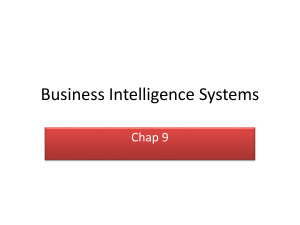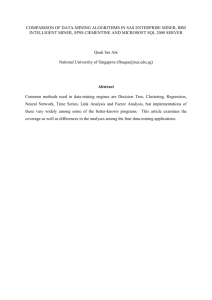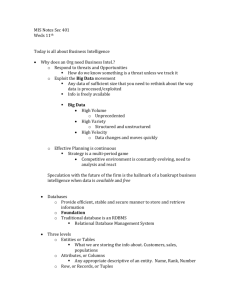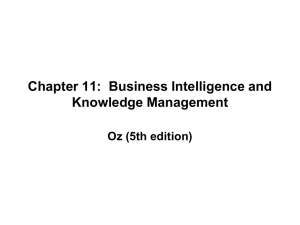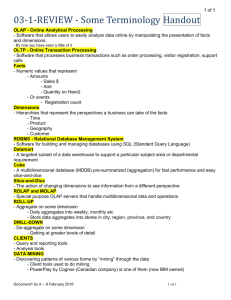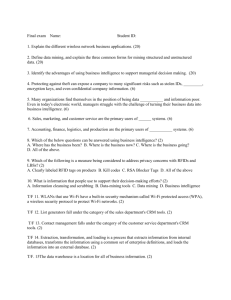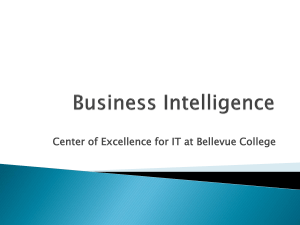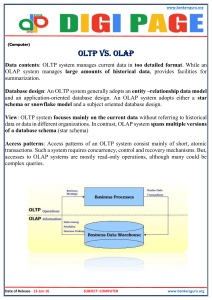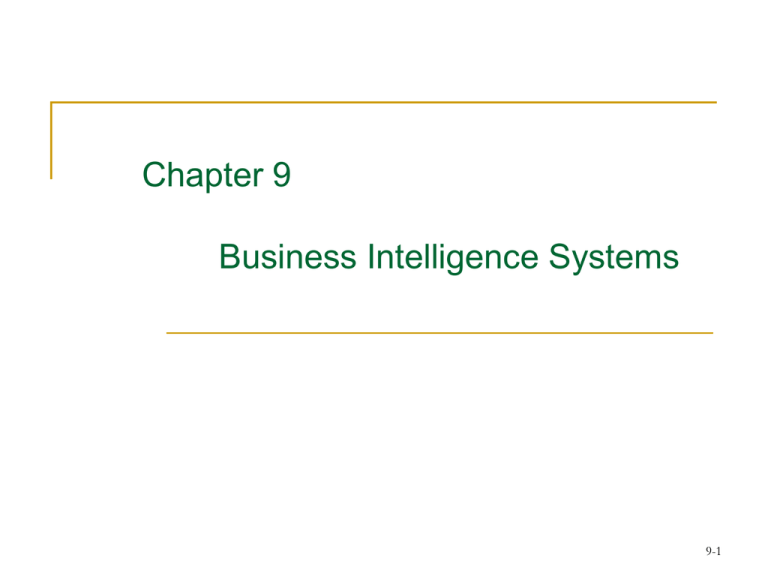
Chapter 9
Business Intelligence Systems
9-1
What is Business Intelligence?
Information that contains patterns, relationship, trends, etc.
Intelligent processing: The information needs to be found or
produced
Challenge: There is not too much data for humans to analyze.
9-2
Business Intelligence Tools
Reporting Tools – Wagemart Lab is a great example
Data Mining Tools – Market Basket Lab
reduced a complex database into Total Cost and Average Rating
Found association rules with the highest confidence and quality
Walmart likely has a Petabytes of data
1,000,000,000,000,000 bytes
Online Analytical Processing (OLAP) – Pivot Chart
Sliced the data by dimension to find relationships
Drilled down to find more subtle patterns
9-3
Q1 – Why do organizations need business intelligence?
Computers gather and store enormous amounts of data. 403
petabytes of new data were created in 2002.
An estimated 2,500 petabytes, or 2.5 exabytes of new data were
generated in 2007.
Business intelligence is comprised of information that contains
patterns, relationships, and trends about customers, suppliers,
business partners, and employees.
Business intelligence systems process, store, and provide useful
information to users who need it, when they need it.
9-4
9-5
Q2 – What business intelligence systems are available?
A BI tool is a computer program that implements the logic of a particular
procedure or process.
A BI application uses BI tools on a particular type of data for a
particular purpose.
A BI system is an information system that has all five components
(hardware, software, data, procedures, people) that delivers the results
of a BI application to users.
9-6
Q3 – What are typical reporting applications?
Basic reporting operations
include sorting, grouping,
calculating, filtering, and
formatting.
This figure shows raw data
before any reporting operations
are used.
Fig 9-2 Raw Sales Data
9-7
Q3 – What are typical reporting applications?
This figure shows even better information that’s been filtered and
formatted according to specific criteria.
Fig 9-5 Sales Data Filtered to Show Repeat Customers
9-8
Q3 – What are typical reporting applications?
RFM Analysis
R = how recently a
customer purchased your
products
F = how frequently a
customer purchases your
products
M = how much money a
customer typically spends
on your products
The lower the score, the
better the customer.
Fig 9-6 Example of RFM Score Data
9-9
Q3 – What are typical reporting applications?
Online Analytical Processing (OLAP) is more generic than RFM
dynamic ability to sum, count, average
Reports, also called OLAP cubes, use
Dimensions which are characteristics of a measure. In the figure below a
dimension is Product Family.
Fig 9-7 OLAP Product Family by Store Type
9-10
Q3 – What are typical reporting applications?
This figure shows how you can alter the format of a report to provide
users with the information they need to do their jobs.
Fig 9-8 OLAP Product Family & Store Location by Store Type
9-11
Q3 – What are typical reporting applications?
This figure shows how you can divide data into more detail by drilling
down through the data.
Fig 9-9 OLAP Product Family & Store Location by Store Type, Drilled Down to Show
Stores in California
9-12
Q3 – What are typical reporting applications?
OLAP servers are special products that read data from an
operational database, perform some preliminary calculations,
and then store the results in an OLAP database
Fig 9-10 Role of OLAP Server & OLAP Database
9-13
Q4 – What are typical data-mining applications?
Data Mining
statistical techniques to find patterns and relationships
classification and prediction.
Data mining techniques are a blend of statistics and mathematics,
and artificial intelligence and machine-learning.
9-14
Q4 – What are typical data-mining applications?
Unsupervised data-mining characteristics:
No model or hypothesis exists before running the
analysis
Analysts apply data-mining techniques and then
observe the results
Analysts create a hypotheses after analysis is
completed
Cluster analysis, a common technique in this
category groups entities together that have similar
characteristics
9-15
Q4 – What are typical data-mining applications?
Supervised data-mining characteristics:
Analysts develop a model prior to their analysis
Apply statistical techniques to estimate parameters
of a model
Regression analysis is a technique in this category
that measures the impact of a set of variables on
another variable
Neural networks predict values and make
classifications
9-16
Q4 – What are typical data-mining applications?
Market-Basket Analysis is a data-mining tool for
determining sales patterns.
helps businesses create cross-selling opportunities.
Support—the probability that two items will be
purchased together
P(AB)
Confidence—a conditional probability estimate
A B
=
P(AB)/P(A)
ABCD EF = P(ABCDEF)/P(ABCD)
9-17
decision tree
>
9-18
Q4 – What are typical data-mining applications?
A decision tree is a hierarchical arrangement of criteria that predicts
a classification or value.
It’s an unsupervised data-mining technique that selects the most
useful attributes for classifying entities on some criterion.
It uses if…then rules in the decision process.
Pivot Chart Lab combines Data Mining + OLAP
Pivot Chart is an OLAP report that helped us find important attributes,
cutoffs and patterns
But eventually we used the results to make a hypothesis to help make
predictions
Fig 9-14 Credit Score Decision Tree
9-19
Q5 – What is the purpose of data warehouses and data marts?
9-20
Q5 – What is the purpose of data warehouses and data marts?
Here’s the difference between a
data warehouse and a
data mart
9-21
Q6 – What are typical knowledge-management applications?
The characteristics and goals of knowledge
management applications and systems are to
Create value for an organization from its
intellectual capital
Share knowledge among and between
employees, managers, suppliers, and
customers
Include knowledge that is known to exist in
documents or employees’ brains
9-22
Q6 – What are typical knowledge-management applications?
The characteristics and goals of knowledge
management applications and systems are to
Foster innovation by encouraging the free
flow of ideas
Improve customer service by streamlining
response times
Boost revenues by getting products and
services to market faster
© Pearson Prentice Hall
2009
9-23

